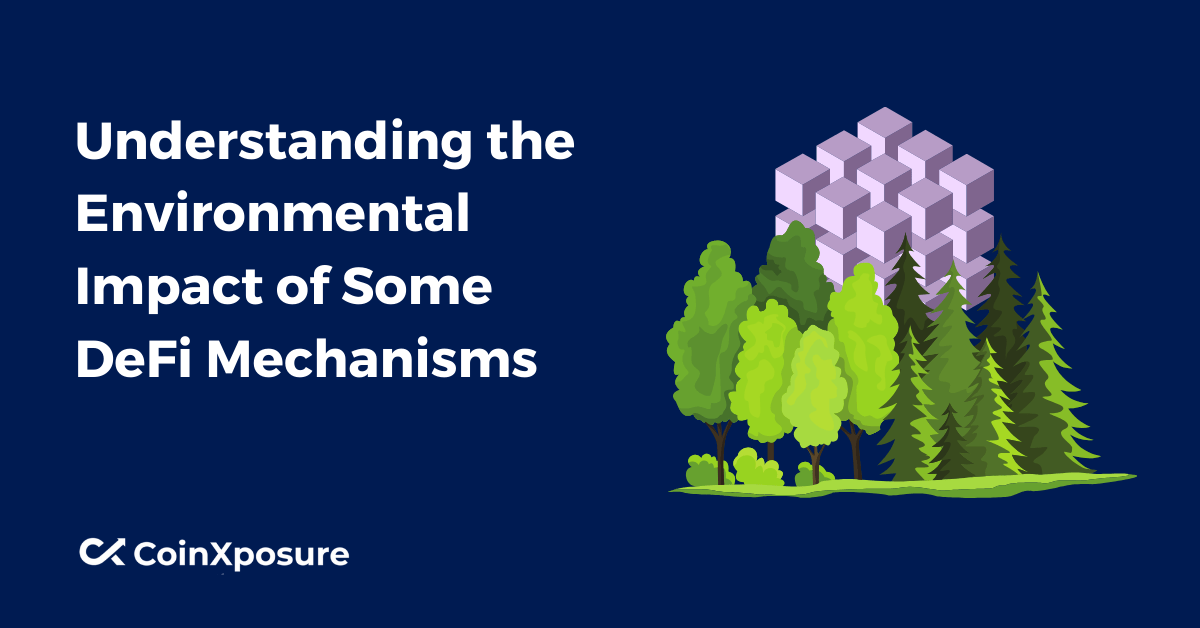
Understanding the Environmental Impact of Some DeFi Mechanisms
Decentralized Finance (DeFi) has emerged as a transformative force in the financial landscape, offering innovative solutions that challenge traditional centralized systems.
However, as the popularity of DeFi mechanisms like decentralized exchanges (DEX), yield farming, and liquidity provisioning grows, so does the need to assess their environmental impact.
This article sets the stage for exploring the environmental implications of various DeFi mechanisms, considering factors such as energy consumption, carbon footprint, and resource utilization.
Understanding these impacts is crucial for promoting sustainable development within the DeFi ecosystem and mitigating potential environmental consequences.
Overview of DeFi Mechanisms
Decentralized Exchanges (DEX)
- DEX platforms facilitate peer-to-peer trading of cryptocurrencies without the need for intermediaries.
- Users retain control of their funds through non-custodial wallets, enhancing security and privacy.
- Popular DEX platforms include Uniswap, SushiSwap, and PancakeSwap.
Yield Farming
- Yield farming involves providing liquidity to DeFi protocols in exchange for rewards, typically in the form of additional tokens or fees.
- Users stake their assets in liquidity pools, allowing them to earn yields by facilitating trading and lending activities.
- Yield farming strategies vary in complexity and risk, ranging from simple liquidity provision to more advanced yield optimization techniques.
Liquidity Provisioning
- Liquidity provisioning refers to the process of supplying assets to liquidity pools on DeFi platforms to facilitate trading and lending.
- By providing liquidity, users contribute to the efficiency and liquidity of decentralized markets while earning rewards in return.
- Liquidity provisioning plays a vital role in ensuring price stability and reducing slippage in decentralized trading environments.
These DeFi mechanisms form the backbone of decentralized finance, offering users unprecedented access to financial services and opportunities for yield generation.
However, understanding their functionality and implications is essential for navigating the rapidly evolving DeFi landscape effectively.
Environmental Impact Assessment
Energy Consumption
- Proof of Work (PoW) vs. Proof of Stake (PoS): PoW-based blockchains, like Bitcoin, consume substantial amounts of energy through computational puzzles to validate transactions.In contrast, PoS mechanisms, like Ethereum’s transition to Ethereum 2.0, aim to significantly reduce energy consumption by replacing mining with staking.
- Electricity Usage Comparison: Analyzing the energy consumption of DeFi mechanisms relative to traditional financial systems provides insights into their environmental footprint.
Carbon Footprint
- Measurement Methodologies: Assessing the carbon footprint of DeFi mechanisms involves quantifying the emissions associated with energy consumption and infrastructure maintenance.
- Emissions Comparison with Traditional Finance: Contrasting the carbon footprint of DeFi with that of traditional financial systems highlights the potential environmental benefits or drawbacks of decentralized finance.
Resource Utilization
- Hardware Requirements: Evaluating the hardware requirements for mining and validating transactions sheds light on the environmental impact of resource-intensive processes.
- Electronic Waste Generation: Examining the lifecycle of hardware components used in DeFi mechanisms can uncover the generation of electronic waste and its environmental implications.
Understanding the environmental impact of DeFi mechanisms is essential for fostering sustainable development within the blockchain ecosystem.
By assessing energy consumption, carbon footprint, and resource utilization, stakeholders can identify areas for improvement and implement strategies to mitigate environmental harm.
Mitigation Strategies
Transition to Proof of Stake (PoS)
- Encourage blockchain networks to transition from energy-intensive PoW consensus mechanisms to more sustainable PoS models.
- Promote the adoption of PoS-based protocols like Ethereum 2.0, which significantly reduce energy consumption and carbon emissions.
Energy-Efficient Consensus Mechanisms
- Explore and develop alternative consensus mechanisms that prioritize energy efficiency while maintaining network security and decentralization.
- Research and implement novel consensus algorithms, such as proof of authority (PoA) or delegated proof of stake (DPoS), to reduce energy consumption without compromising on blockchain integrity.
Offsetting Carbon Emissions
- Collaborate with environmental organizations and initiatives to offset the carbon emissions generated by DeFi mechanisms.
- Implement carbon offset programs within DeFi protocols, where a portion of transaction fees or rewards is allocated to carbon offset projects, such as reforestation or renewable energy initiatives.
By implementing these mitigation strategies, the DeFi ecosystem can minimize its environmental impact while continuing to innovate and expand financial inclusion opportunities.
It’s crucial for stakeholders to prioritize sustainability and adopt responsible practices to ensure the long-term viability of decentralized finance.
Future Outlook
Technological Advancements
- Continued research and development efforts are expected to yield more energy-efficient consensus mechanisms and infrastructure solutions for DeFi protocols.
- Innovations in blockchain scalability, interoperability, and optimization will further enhance the efficiency and sustainability of decentralized finance.
Regulatory Developments
- Regulatory frameworks governing blockchain and cryptocurrency industries may evolve to incorporate environmental considerations and incentivize sustainable practices.
- Increased transparency and accountability requirements could drive DeFi projects to prioritize environmental sustainability in their operations and governance.
Industry Collaboration
- Collaboration among blockchain developers, environmental organizations, and policymakers will foster the exchange of ideas and best practices for mitigating the environmental impact of DeFi mechanisms.
- Partnerships with renewable energy providers and carbon offset projects may become more prevalent as DeFi stakeholders seek to address their carbon footprint.
The future outlook for understanding and addressing the environmental impact of DeFi mechanisms is promising.
By embracing technological advancements, regulatory developments, and industry collaboration, the DeFi ecosystem can strive towards sustainability while continuing to innovate and grow.
Conclusion
Understanding the environmental impact of DeFi mechanisms is essential for promoting sustainable development within the blockchain ecosystem.
Assessing factors such as energy consumption, carbon footprint, and resource utilization provides valuable insights into the environmental implications of decentralized finance.
While certain DeFi mechanisms, such as Proof of Work-based consensus algorithms, may have significant environmental drawbacks, there are opportunities to mitigate these impacts through strategies like transitioning to Proof of Stake, adopting energy-efficient consensus mechanisms, and offsetting carbon emissions.
Looking ahead, technological advancements, regulatory developments, and industry collaboration offer avenues for improving the sustainability of DeFi protocols.
By prioritizing responsible practices and embracing innovation, the DeFi ecosystem can continue to expand financial inclusion opportunities while minimizing its environmental footprint.
Ultimately, fostering a balance between technological innovation and environmental stewardship is crucial for ensuring the long-term viability and success of decentralized finance.





